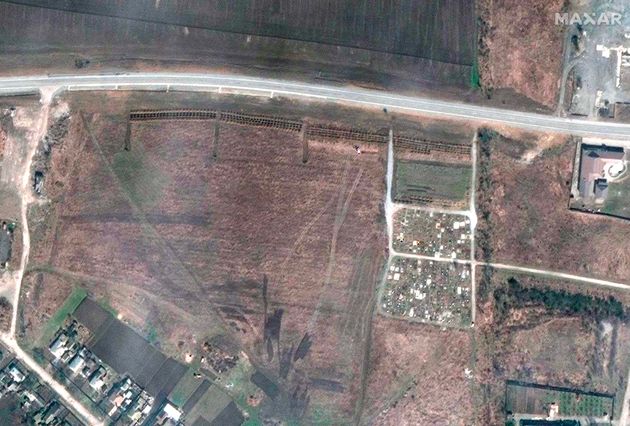via Associated Press
WAR IN UKRANE – “The occupiers are said to have buried between 3 and 9,000 inhabitants” in Manhush. According to the mayor of Mariupol, Vadym Boychenko, the Russians are said to have hidden the bodies of the inhabitants murdered in the port city in mass graves. The American company Maxar Technologies confirms with the help of images the presence of a gigantic mass grave near Mariupol, a city of which Russia claim check†
These satellite images, released Thursday, April 21, show “the existence of a mass grave site in northwestern Manhush,” a village 20 kilometers west of Manhush, the company said. Mariupol† the New York Times† who analyzed these images estimated that about 300 holes were dug around the village cemetery. These graves would have been dug in two weeks.
“Thirty meters of holes”
The first rows of these mass graves were photographed between March 23 and 26, the American daily reports. Photos taken on April 6 show a “dramatic expansion of the site, with more than 200 holes” dug recently, with mass graves extending over “about half an acre of land”. “The graves are arranged in four sections of linear rows and contain more than 200 new graves,” said Maxar Technologies.
In this village of Manhush alone, “the inhabitants are said to have buried between 3 and 9,000 inhabitants”, the Mariupol town hall confirmed on Telegram. “They dig 30-meter holes and bring the bodies of our residents of Mariupol in trucks,” he said during a press conference on YouTube. “The bodies were brought back by truck and were just piled up,” Piotr Andryushchenko, a deputy mayor of Mariupol, added on Telegram.
According to Vadym Boychenko, Russian bombing raids have claimed at least 20,000 lives in Mariupol since the beginning of the siege, which lasted nearly two months. According to the Ukrainian authorities, they were killed in the fighting, but also from the lack of food, water and electricity.
Calling the troops “the invaders”, Vadym Boychenko, quoted by the Guardian† claims they are trying to “hide the evidence of their crimes”, by burying their victims near the “cemetery near a gas station”.
It is not the first time that Russian troops have been accused of killing countless civilians. to Boutchain light of the influx of discovered dead after the withdrawal of the russians, the Ukrainians had to bury the victims in mass graves. The corpses, some with their hands tied, were mostly left in the street by Russian soldiers.
An investigation into the “atrocities” committed near Kiev
Since mid-April, 18 experts from the Institute for Criminal Research of the National Gendarmerie (IRCGN) have been working to help identify the victims buried in the largest mass grave in this city northwest of Kiev. According to Boutcha mayor Anatoli Fedoruk, more than 400 bodies have been discovered in his city since the withdrawal of Russian troops.
Until Motyzhin, west of the Ukrainian capital, residents discovered a mass grave in a forest. The victims are said to have been executed by Russian soldiers. The mayor of Motyzhin, Olga Sukhenko, her husband and son were killed before being thrown into this mass grave. the AP agency reported at the beginning of April†
Makeshift graves were also discovered near a hospital in the ruined town of Borodianka, northwest of Kiev. Authorities said nine civilians, many of them shot, have been exhumed from these graves. They showed “signs of torture”, police said.
Experts investigating war crimes charges against Russian troops have collected more than 1,000 civilian bodies from streets, courtyards or makeshift graves around the Ukrainian capital. This investigation is part of the documentation of what Oleksandr Pavliuk, head of Kiev’s regional military administration, described as “atrocities” committed after the invasion of Russian troops, who were subsequently forced to withdraw from the area.
See also on The HuffPost: ‘Satan II’: Russia Tests Its Sarmat Missile





